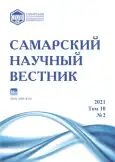Scots pine in different ecological conditions in the south of the Central Black Earth region: features of the genetic structure of the glutamate dehydrogenase locus
- Authors: Serdyukova A.P.1, Kamalova I.I.1, Vnukova N.I.1
-
Affiliations:
- All-Russian Research Institute of Forest Genetics, Breeding and Biotechnology
- Issue: Vol 10, No 2 (2021)
- Pages: 90-93
- Section: General Biology
- URL: https://journals.rcsi.science/2309-4370/article/view/78101
- DOI: https://doi.org/10.17816/snv2021102113
- ID: 78101
Cite item
Full Text
Abstract
A comparative analysis of two Scots pine plantations growing in different ecological conditions of the steppe zone in the south of the Central Black Earth region (Kantemirovsky District of the Voronezh Region) has been carried out. One plantation is located in a relatively ecologically clean area, outside the urban environment, the other one – within the village Kantemirovka. The enzyme system has been studied; it is an important link in the main metabolic pathways in plant organisms influencing the general condition of plants. In the studied stands the genetic structure of the glutamate dehydrogenase locus has been analyzed, one of the alleles of which (Gdh-1¹) in Scots pine is an embryonic semi-metal. It has been found that in a weakened plantation located in an urban environment and exposed to increased anthropogenic impact, the proportion of this allele and the proportion of genotypes homozygous for it is significantly (p < 0,01) higher than in the population from an ecologically clean zone. It is known that organisms with semi-lethal genes in their genotype possess a complex of compensatory genes, which determines their increased resistance to unfavorable factors. An increase in the proportion of semi-lethal alleles in a plantation growing under anthropogenic load can be an adaptive mechanism for increasing resistance at the population level to stress effects of different nature.
Full Text
##article.viewOnOriginalSite##About the authors
Alina Petrovna Serdyukova
All-Russian Research Institute of Forest Genetics, Breeding and Biotechnology
Email: ali.serdyukova@yandex.ru
junior researcher of Ecological Genetics Laboratory
Russian Federation, VoronezhIrina Ivanovna Kamalova
All-Russian Research Institute of Forest Genetics, Breeding and Biotechnology
Email: kamairi@yandex.ru
candidate of biological sciences, leading researcher, head of Biochemistry, Molecular Genetics and Plant Physiology Laboratory
Russian Federation, VoronezhNatalya Ivanovna Vnukova
All-Russian Research Institute of Forest Genetics, Breeding and Biotechnology
Author for correspondence.
Email: natalya.vnuckova@yandex.ru
researcher of Biotechnology Laboratory
Russian Federation, VoronezhReferences
- Паршутина Л.П. О южной границе лесостепи в пределах Воронежской области // Известия Самарского научного центра РАН. 2012. Т. 14, № 1 (6). С. 1634–1637.
- Кузнецова Н.Ф. Засухи в лесостепной зоне Центрально-Черноземного региона и критерии оценки их интенсивности // Известия Саратовского университета. Новая серия. Серия Науки о Земле. 2019. Т. 19, № 3. С. 142–148.
- Шевцов И.С. Особенности и проблемы урбанизации ЦЧР в конце ХХ – начале ХХI веков // Вестник Воронежского государственного университета. Серия: География. Геоэкология. 2006. № 1. С. 17–20.
- Майснер Т.Н. Урбанизация и экология городской среды: риски и перспективы устойчивого развития // Гуманитарий Юга России. 2020. Т. 9 (43), № 3. С. 190–201.
- Гнедаш Д.С. Особенности сосновых форпостов степной зоны // Вопросы степеведения. 2011. № 9. С. 38–43.
- Тарханов С.Н., Бирюков С.Ю. Определение влияния атмосферного загрязнения на морфометрические показатели и состояние ассимиляционного аппарата сосны и ели в бассейне Северной Двины // Сибирский экологический журнал. 2012. № 3. С. 407–414.
- Камалова И.И., Клушевская Е.С., Внукова Н.И., Сердюкова А.П. Динамика генетической структуры локуса глутаматдегидрогеназы в онтогенезе потомств разных форм сосны обыкновенной // Современная лесная наука: проблемы и перспективы: мат-лы всерос. науч.-практ. конф. 20–22 декабря 2017 г., г. Воронеж, Российская Федерация. Воронеж, 2017. С. 79–84.
- Струнников В.А. Новая гипотеза гетерозиса и ее научное и практическое значение // Вестник российской сельскохозяйственной науки. 1983. № 1 (316). С. 34–40.
- Камалова И.И., Камалов Р.М. Динамика генетической структуры локуса глутаматдегидрогеназы как маркер состояния насаждений сосны обыкновенной // Мониторинг и оценка состояния растительного мира: мат-лы междунар. науч. конф. Института экспериментальной ботаники им. Купревича НАН Беларуси. 22–26 сентября 2008 г., г. Минск, Республика Беларусь. Минск: Право и экономика, 2008. С. 167–168.
- Анохина Г.Б., Оя П.С., Епринцев А.Т. Экспрессия генов gdh-1 и gdh-2 глутаматдегидрогеназы при прорастании семян кукурузы Zea mays L. // Вестник Воронежского государственного университета. Серия: Химия. Биология. Фармация. 2020. № 3. С. 31–36.
- Тарханов С.Н., Бирюков С.Ю. Определение влияния атмосферного загрязнения на морфометрические показатели и состояние ассимиляционного аппарата сосны и ели в бассейне Северной Двины // Сибирский экологический журнал. 2012. № 3. С. 407–414.
- Богатина Н.И., Шейкина Н.В. Влияние электрических полей на растения // Ученые записки Таврического национального университета им. В.И. Вернадского. Серия «Биология, химия». 2011. № 1. С. 10–17.
- Сердюкова А.П. Сравнительный анализ признаков жизненного состояния Pinus sylvestris L. в условиях антропогенной нагрузки и на экологически благоприятной территории // Международный журнал гуманитарных и естественных наук. 2020. № 8 (47). С. 10–13.
- Сердюкова А.П. Оценка общего состояния и семенной продуктивности Pinus sylvestris L. в разных климатических зонах Воронежской области // Международный журнал гуманитарных и естественных наук. 2019. № 9–2. С. 10–12.
Supplementary files







